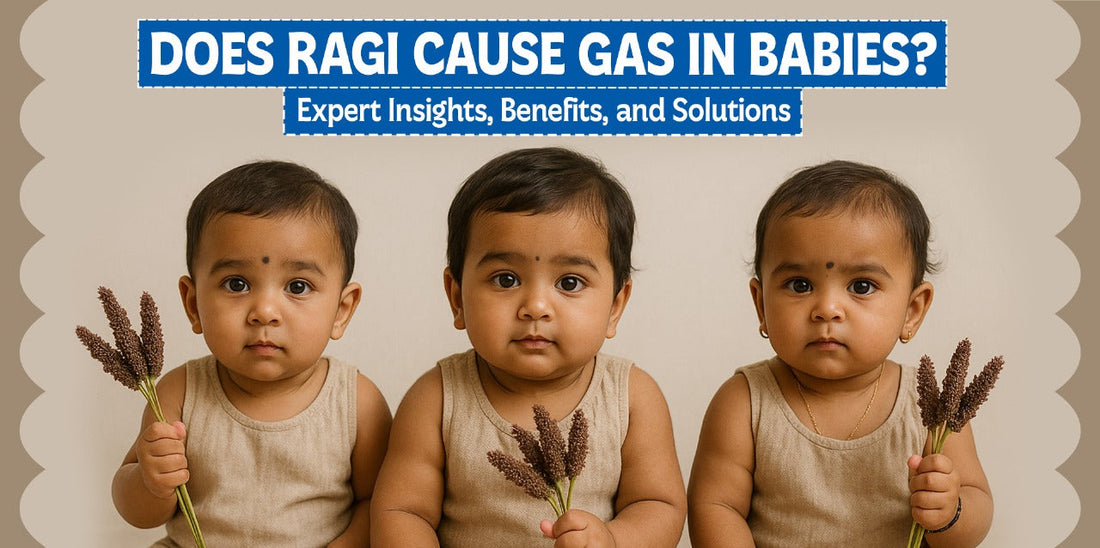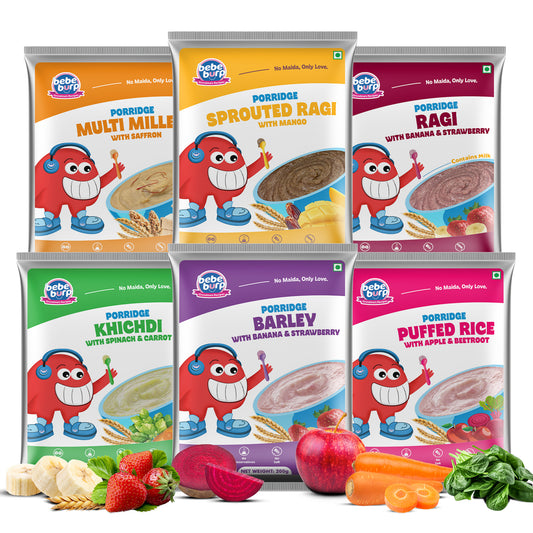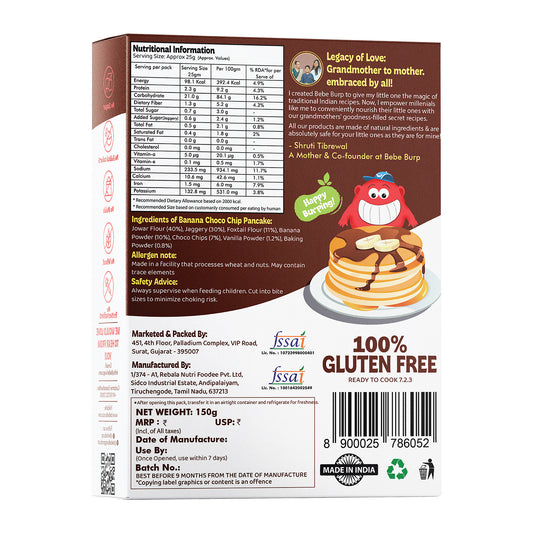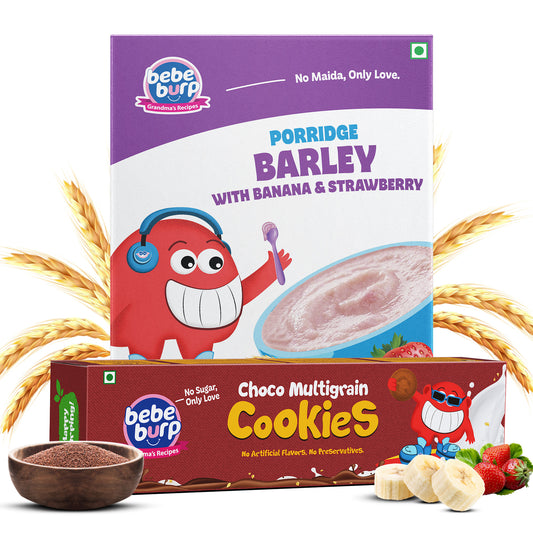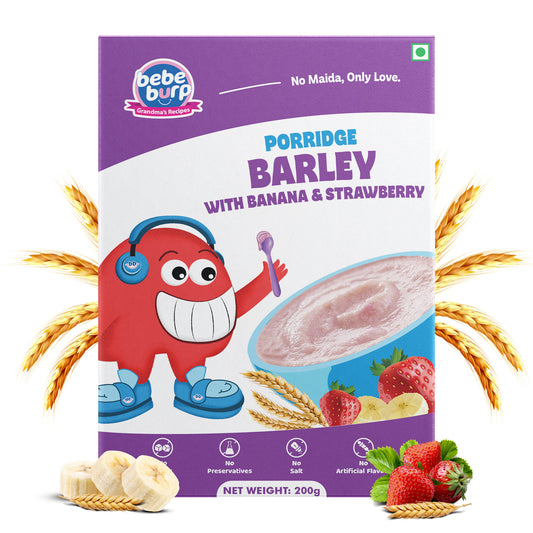Ragi (Finger Millet) is a nutrient-rich and easily digestible first food that many parents choose when introducing solids to their babies. But many parents still wonder – does ragi cause gas in babies?
In most cases, the answer is no. However, some babies may experience gas if:
- Ragi is introduced too early
- It is served in large quantities
- The baby’s digestive system is still developing
- It is not cooked or diluted properly
To avoid gas, it is best to:
- Start with small quantities
- Make sure the ragi is well cooked and soft
- Introduce it slowly as your baby adjusts to solids
In this blog, we will learn why ragi is good for babies, what causes gas, and easy tips to keep your baby comfortable during this transition.
What is Ragi? Nutritional Value and Benefits for Babies
Ragi or finger millet is a naturally gluten free grain thus used in baby food (India is a major consumer of Ragi). It is beloved by parents as it is:
- Digestive (by making it the correct way)
- Affordable and commonplace
- Very multi purpose (porridge, dosa, pancakes etc)
Key Nutrients in Ragi Beneficial for Baby Growth
Ragi is a super food. This is the reason why it is so good to Babies:
- Calcium: It is essential in the development of bones and teeth.
- Iron: Aids in the making of red blood cells and prevents anemia.
- Fiber: It helps to digest but may result in gas.
- Amino acids: Can be useful in tissue growth and repair.
Introducing Ragi as a First Solid Food
Small and steady
- Ragi flour porridge first thin consistency made from water or breastmilk/formula
- Begin with 1–2 tsp.
- Start with this in the diet and wait 3–5 days before introducing another new food.
- It’s best to consult a pediatrician to make sure you are ready to start solid introductions.
Growth of Infant Digestive System
Baby tummies have a very new system of digesting solid foods. They might not have sufficient enzymes to digest complex food like ragi in the beginning which causes gas.
Fiber Content and Its Effect on Baby’s Tummy
Babies' digestive systems give me thigh activity in the tummy thanks to all the fiber, but too much at once can also be a real shock. Ragi is very high in fibers and that fiber gets fermented in the tummy and it produces gas. Start out slow so that their gut can adjust.
Risk of Allergic Reaction or Sensitivity
Rarely also, allergies or sensitivities to ragi can lead to gas, rashes, or bloating. If symptoms show up, attempt to maintain an entry into a food diary, and see with the pediatrician.
Why Ragi is a Popular First Food for Babies
- Gluten-free and digestible very easily by nature
- Full of calcium and iron
- Enhances immunity and assists in gaining weights healthily
- Not only does this provide energy, but also helps in gut health, provided one prepares it well
How to Prevent Gas in Babies When Feeding Ragi
Proper Soaking and Sprouting Techniques
When ragi is soaked and sprouted, the compounds that make it give gas is reduced and digestibility is improved.
How to soak/sprout:
- Ragi grains should be soaked for 6-8 hours or overnight.
- Wash and dry.
- Store in a moist cloth and let it sprout for 24–48 hours.
Cooking Methods to Enhance Digestibility
- Bloating can be lessened by roasting ragi flour and cooking it.
- Cook completely- ragi is not easily digested when it is half-cooked.
- To have a smoother result, use a pressure cooker or slow cooker.
Combining Ragi with Other Easily Digestible Foods
- Combine with fruit purees (apple, pear etc.) or sweet potato puree.
- At first do not combine with other high-fiber foods.
- Offer gradually and watch the reaction of the baby.
Best Remedies and Solutions for Gassy Babies
Gentle Massage and Bicycle Kicks
- Massage clockwise in a gentle rub in a clockwise motion around the tummy.
- Gently move your baby's legs in a bicycle motion.
- The methods are beneficial in the release of trapped gas naturally.
Burping Techniques and Feeding Positions
- Burp baby during meal and after meal.
- Over-the-shoulder, sitting up on your lap, or tummy-down across your lap are good to be tried.
- Hold the baby's head a little up when feeding him/her to avoid the air swallow.
Over-the-Counter Solutions and Natural Aids
- Simethicone drops: Consult the doctor first, but it is safe.
- Gripe water: A herbal solution that contains fennel or ginger once more do ask your pediatrician first.
When to Consult a Pediatrician About Baby Gas
Call your pediatrician if gas is accompanied by:
- Vomiting
- Diarrhea
- Fever
- Blood in stool
- Extreme fussiness or lethargy
- Poor weight gain
It’s always better to ask if you're unsure—doctors can rule out other concerns.
Success Stories and Parent Experiences with Ragi
There are so many parents who can vouch about ragi being an initial food and a vast majority of them observe their children have stronger bones, digestive capacity is increased, and they have a better appetite.
There are also those citing little gassiness in the initial stages, but this subsided when they prepared well or reduced the portions.
Advice of real moms:
-
“Sprouting helped a lot—no more tummy aches!”
-
“I paired ragi with mashed banana, and my baby loved it.”
- “Ragi gave my daughter great energy, but I had to reduce the quantity at first.”
Conclusion
Ragi is a great baby food and contains nutrients which provide great help in growth, immunity and digestion.
Although it may trigger gas in some babies, it makes a lot of difference when it is prepared well and in an adequate quantity.
All the babies are unique, so proceed carefully, be attentive, and do not be afraid to consult a specialist.
FAQs
Q1) What is ragi and why is it so good to use with babies?
Ans: Ragi is a food with lots of nutrients that are rich in calcium, iron, and fiber, a good grain that supports bone development of bones and ease of digestion in infants.
Q2) How would ragi result in gas in my baby?
Ans: The fiber that is present in ragi and also the fact that your baby has a developing system of digestion means ragi can cause gas when introduced at a pace that is too fast or in quantities that are too high.
Q3) What symptoms do I need to check that my baby had gas in ragi?
Ans: Pay attention to such signs as fussiness, pulling the legs up, hard stomach, or a lot of burping or passing gases after eating.
Q4) Can Ragi be prepared in a method that will lessen the gases in babies?
Ans: Yes-soak, sprout and cook ragi. It helps mixing it with easily digestible foods such as fruit puree.
Q5) How can I make my baby feel better when he or she has gas?
Ans: Tummy massage, bicycle kicks, sitting feeding, lots of burping and a warm bath can relieve trapped wind.
Q6) Other than the gas issues, what are the key health advantages of feeding my baby ragi?
Ans: Ragi helps with the health of bones, increases iron content in the body, enhances immunity through the body and gives a constant amount of energy to the growing bodies.

